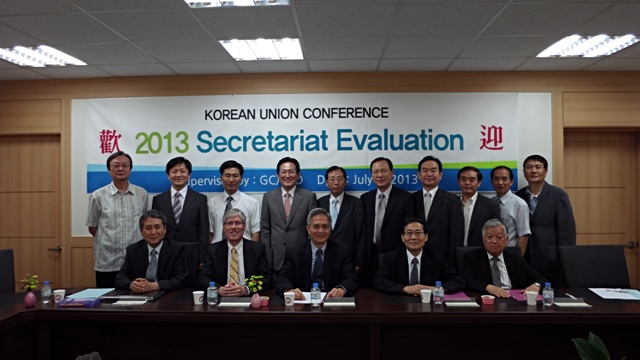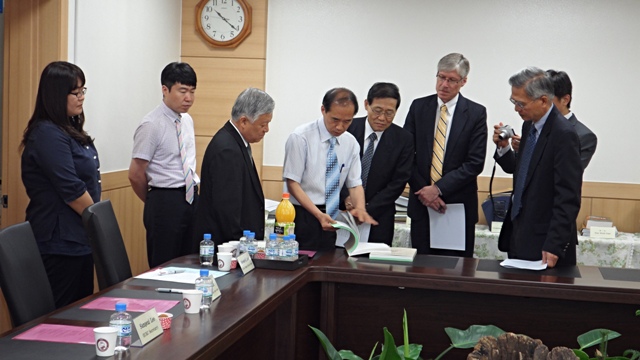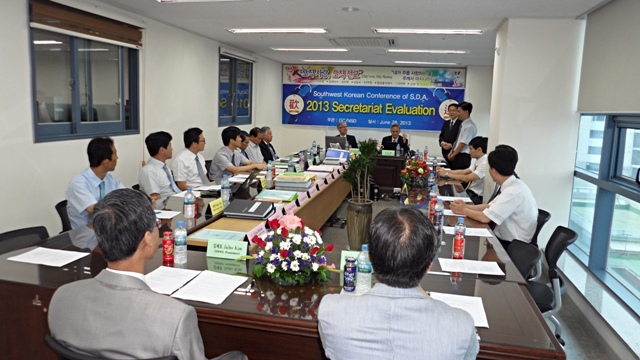June 25-July 1, 2013 the secretariat evaluations for the Korean Union Conference with its 5 local conferences were conducted. The participants for the evaluation were the representatives from the General Conference, the Northern Asia-Pacific Division, and the Korean Union Conference and local conferences. The interview participants to the each entity evaluation were the officers, some departmental directors, office staff, local church pastors, and lay peoples.
The GC Secretary G.T. Ng and Undersecretary Myron Iseminger led the evaluations with the NSD Secretary Akeri Suzuki and Assistant Secretary Sungsub Song, and Chinese Union Mission Secretary Daniel Jiao. The preparations and displays for the evaluations have been well organized by the secretariat teams under the leadership of the Korean Union Conference Secretary ChiYang Moon and Associate Secretary WongYong Jeong with his colleagues, 5 local conferences’ secretaries: East Central Korean Conference Secretary Sang Eui Lee, West Central Korean Conference Secretary SungGu Choi, South East Korean Conference Secretary SiChang Nam, Middle West Korean Conference Secretary ChangSoo Huh, South West Korean Conference Secretary JangHo Shin.
While the secretariat office addresses with the two major parts which are clergical or administrative area and the mission, in practice, the evaluation team’s scoring is limited to the administrative part. It is classified into the following 6 subjects: (1) Roles of the secretary, (2) Leadership qualities of spiritual and administrative areas, (3) Interpersonal and organizational relations, (4) Internal executive responsibilities including committees, sessions, policies, records, statistics, (5) Facilities, and (6) Filings.



During the five local conference evaluations, it was found that Conference Secretary plays other roles beside the Secretary such as Sabbath School and Personal Ministries Departmental Director. In some conference, the Secretary is responsible for 5-7 areas. One of the recommendations through the consensus from the evaluation participants is that some burdens of the Secretary should be shared or reduced in order to avoid overlooking some important functions. However there is the possibility of strengthening the mission works by getting momentum from the secretariat which is one of three administrative units, the other two being Presidential and Treasury. In fact, since 2010, the Adventist Mission has become part of Secretariat at the GC, and the GC Secretariat Office has been providing support, promotion and strategic input for the mission program of the church.
The main purpose of the evaluation is not just to test, but to provide instructions, and strengthen or improve the weak points. All the participants could have more learning experiences regarding the church and secretariat works. After the completion of the one week evaluations by traveling throughout the Korea, Dr. G.T. Ng said, “It has been a profitable experience for all of us, particularly in terms of getting to know the leaders and the operations of the conferences up close. We praise the Lord for the excellent facilities some of these conferences have. The dynamism of the conferences and union is very much alive.”
The secretariat evaluation is conducted once every quinquennium. In July 24-26, 2012 it was performed for the Japan Union Conference and Mongolia Mission Field. For the Chinese Union Mission and Taiwan Conference, it is scheduled in February 11-13, 2014.
News ariticle by SungSub Song, NSD Assistant Secretary
